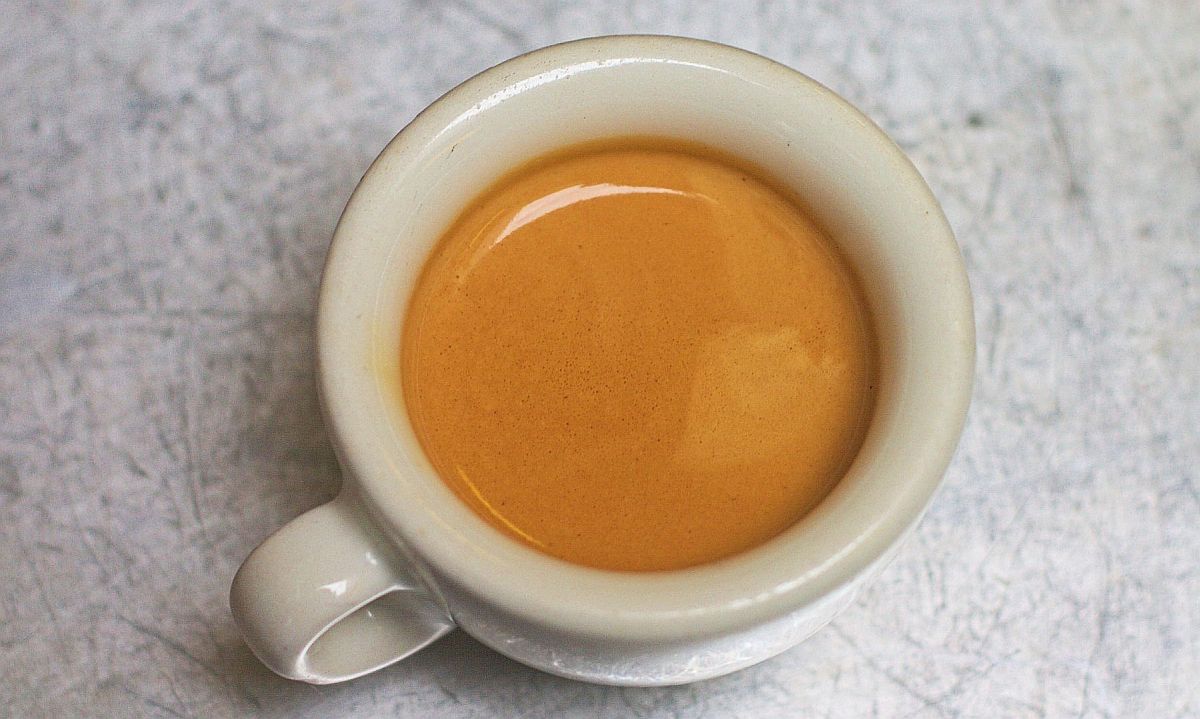The espresso beverage as we know it today, dates back to 1947, when Gaggia introduced the first machine capable of creating consistent high pressure during the shot pulling. The machine was called Gaggia Crema Caffe and was intended for normal commercial use. Before the Gaggia Crema Caffe almost every commercial and consumer espresso machine was steam driven, similar to the modern day Moka pot brewer.

So What is Espresso
Espresso is just one of the many coffee brewing methods. There are many different ways of preparing coffee, including the Moka pot, French press, drip coffee, (many times incorrectly referred to as brewed coffee), vacuum pot and others. Espresso coffee is brewed in its own special way.
Espresso is a beverage that is produced by pushing hot water, between 192F and 204F, at high pressures, through a bed of finely ground, compacted coffee.
A normal single shot, (solo – normale), is approximately 1 to 1.5 ounces of beverage, using approximately 7grams of ground coffee. A normal double is between 2 and 3 ounces, using double the volume of coffee grounds.
The shot is brewed, or pulled rather, for 20 to 30 seconds. The brewing time stays the same for both a single or double shot. Usually, double baskets are bigger, with more screen area, allowing the shot to flow faster. The single baskets restrict the flow more, producing approximately 1 ounces in 25 seconds.
The resulting beverage, either a single or a double, has a dark golden cream, called crema. Crema is one of the visual indicators of a good quality espresso shot.
What Makes Espresso Special?
From a technical perspective, the high pressure is what makes it unique. There are other brewing methods that use pressure during brewing, including Moka pot and some single serve coffee makers, however, none of them use the high pressure that a modern pump driven espresso machine uses.
From a taste perspective, there is nothing like espresso. Espresso is a mini serving of coffee, typically between 1 and 3 oz., but is more concentrated. Think about everything you like and dislike in coffee, enhanced a few times. Add a couple of extra dimensions to that and you have espresso. Concentrated drip coffee, for instance, is not drinkable neat, in my opinion, as opposed to espresso.
The important factors in an espresso are the concentration and the extra dimensions we get because of the pressure. Although espresso is very concentrated, the particular way of brewing changes the flavor profile. We extract more soluble substances from the ground coffee, so an espresso shot has more body.
We extract different solubles from the grounds. For instance, we extract more astringent compounds in a drip coffee than in espresso. This is because the slightly lower extraction temperature and the lower extraction time of the espresso. This is why a very concentrated filter coffee tastes so tannic.
Our coffee flavor dictionary is a great starting point if you need to expand your coffee vocabulary, and espresso flavor knowledge.
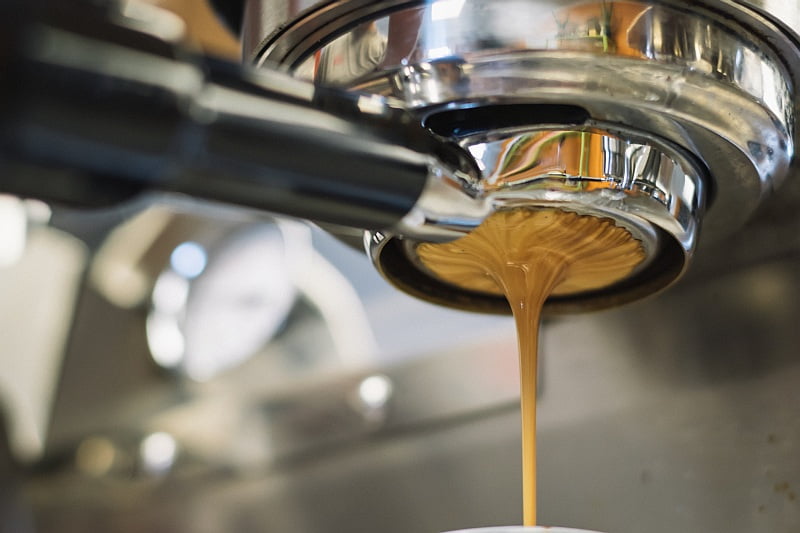
A very distinctive feature is the crema. Crema forms when oils and CO2 are emulsified during extraction. Crema does not contribute very much to the shot's flavor, but it is a sign of a greatly prepared coffee. It suggests the coffee beans are fresh, and the brewing parameters were correctly adjusted. Some beans do not produce much crema, but they make a great espresso shot. This means that crema is a great indicator of a good espresso, but it is not a must.
Lastly, I wanted to underline that espresso is confusing for coffee lovers because too many times is not prepared correctly.
Genuine modern espresso, brewed with a pump or piston driven espresso machine leaves very little error margin. Decent equipment and great coffee are needed to obtain a God Shot. But before we get into the relative ‘torture' that ground coffee is put through to produce a superior espresso, let us take a step back and discuss a bit more the misconceptions about the beverage.
If you are not convinced yet, check my dedicate article, where I show in detail what's so great about espresso.
Is It Espresso or Expresso
Many people mistakenly pronounce or spell it as “expresso” which is incorrect. The coffee beverage name is espresso. This is an Italian word, and was firstly used around 1900 to describe a cup of coffee that was squeezed out, or forced out. The word “espresso” has more meanings in Italian, among which we also have made-to-order, and fast. People who have tried to guess the name origin of the espresso beverage, translated it as “expressly for you”, lose translation of the made-to-order, or brewed fast.
In fact, the word espresso predates the invention of the modern pump driven espresso machine. The term was coined by Luigi Bezzerra and Desiderio Pavoni, who coined the term “cafeé espresso“ in 1906 at the Milan Fair, along with the introduction of their perfect espresso machine at the time, the Ideale. My humble opinion is that the two inventors played a little with the notion, and they specifically chose the word espresso which described three important attributes of the famous beverage.
Some Confusion about Espresso
Many people do not understand espresso as a coffee. Some think of it as a strong bitter jolt of caffeine. Some think espresso is a trendy drink invented by coffee chains to increase revenue. Some think of it as an addition for the milk and coffee beverages. Let's dispel some of these myths and see what truly an espresso is.
I have seen misinterpretations of the term everywhere online, and this only fuels the wrong perception about espresso. A blatant one is the confusion about coffee beans, and roast. There is no such a thing as espresso beans, or espresso roast. A big problem is that roasters often perpetuate this misconception, for marketing purposes.
Espresso Is NOT Just a Strong Coffee
The most common confusion about espresso is about strength. Espresso IS indeed a strong cup of coffee and is about 5 times more concentrated than a cup of drip coffee. However, you cannot make an espresso with a drip coffee maker. Even if you brew it concentrated. In fact, if you brewed the equivalent of an espresso with a drip coffee maker, it would taste awful.
The French press is often seen as an espresso alternative. From a practical perspective, you can make a stronger coffee with a French press, and add frothed milk to it to prepare a latte. However, the straight coffee beverage, without milk or other additions, does not resemble a true espresso brewed with a pump espresso machine.
The Moka pot could in theory qualify as an espresso coffee maker, because it brews using pressure. However, the pressure in a Moka pot is around 1-1.5 bar, which is too low compared to the 9 bar of –pressure we get from a pump driven espresso machine. But we'll get in a bit to a more detailed explanation about brewing using pressure, and why pressure changes everything.
Espresso Is NOT a Type of Coffee Beans
Another common mistake about espresso is the idea that it is a type of coffee beans or a roast.
Espresso is not a type of bean: This is a common misconception, and inaccurate marketing by coffee chains, grocery stores, and even small coffee roasters sometimes. The more dangerous is this information circulates through word of mouth as well. Any coffee bean can be used for espresso, from the most common Brazilian beans to the more exotic Kona and Ethiopian Harar coffee beans. In fact, espresso as any other coffee brewing method, if prepared properly, will retain the characteristics of the bean's origin. This will give you an amazing variety of flavors and notes. And this brings us to the next misconception – the roast.
Espresso is not a Roast Type
Dark roasted coffee beans are often associated with the notion of “espresso beans”. The popular misconception is that espresso can only be roasted one way. Espresso must be super dark and glistening with oils).
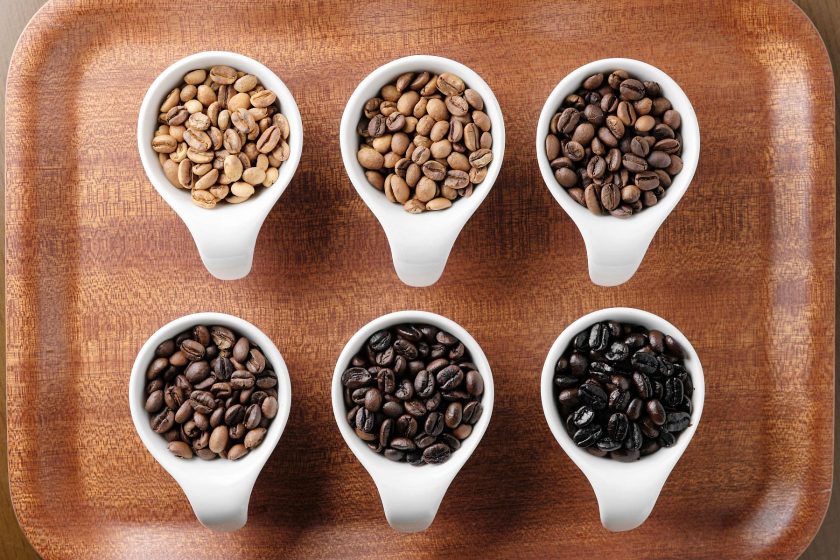
This is not true. In fact, experienced baristas stay away from oily beans, because they lose flavor faster during storage, and because they can be a problem with many grinders. Dark roasts lose the origin flavor, and all coffee tastes about the same. This means that no matter how cheap the coffee beans are, they will taste more or less the same, when roasted very darkly. This is an easy way for large coffee roasting companies to maintain a consistent flavor from batch to batch.
Northern Italian choice of roast for espresso is a medium roast, known as a “Full City” roast. In Sicily, in Southern Italy, the choice of roast for espresso is a dark roast.
In California, the typical “espresso roast” is a dark, close to “French roast”, and in parts of the eastern US, a “cinnamon” roast style is preferred. The takeaway message is that you can make good espresso from almost any roast type; the decision is purely up to your own taste. However, if we want to be objective here, we need to mention that there is a purely technical explanation why dark roasts are preferred for pulling shots. I'll show you why in a bit.
Take a look at our “Best Roast for Espresso” article to learn more about this.
Espresso Is Not a Blend
Espresso is not a blend, we mentioned before that we can use any type of beans. This is true with blends as well. It is not entirely wrong to create a blend that works as an espresso blend. There are some advantages to using a blend, and we'll get to that in a bit. The problem is that many coffee lovers assume that they can only use beans labeled as “Espresso Beans”. While espresso is not a blend, there are certain beans that will make your espresso better. I have an article where I share some of my favorite beans to use for an espresso.
Many high quality micro roasters would disagree with this, however, in my barista career, and later on, as a coffee critic, I have tasted blends that were worse than run-of-the-mill coffee beans. On the other hand, I have tasted famous blends that could not be matched by any single origin coffee, no matter how good.
What Is Special about Espresso Blends and Roasts
Roaster craftsmen work meticulously on their own version of “the perfect espresso blend”. Most of the time they create blends that are amazing, but as I said before, there are many flops.
The reason for blends to exist in the first place, is to create a balance between taste, body, crema volume, and consistency between batches. You cannot have that with a single origin.
For instance, many blends contain a small percentage of Robusta beans. From a flavor perspective, Robusta are not a good choice, they have a rubbery taste that is just not desirable in a coffee. However, Robusta creates a lot of crema, so as long as we can mask the specific Robusta taste with some good Arabica beans, it is a great reason to blend.
Another example is the flavor. Let's take the Brazilian beans. The vast majority of Brazil beans have an intense sweetness, with notes of caramel and chocolate, they have a big body, and a low acidity. The sweetness and the body are exactly what we are looking for in a classical espresso shot. However, modern espresso is more than that, and a little acidity balances the sirupy taste of the Brazilians. Hence the reason to blend.
Takeaway message: there is nothing wrong with using an “espresso blend”, but don't limit yourself to blends. Single origin beans can be amazing choices, though they will probably lack on one or two aspects, compared to blends.
Why Are Dark Roasts Preferred for Espresso?
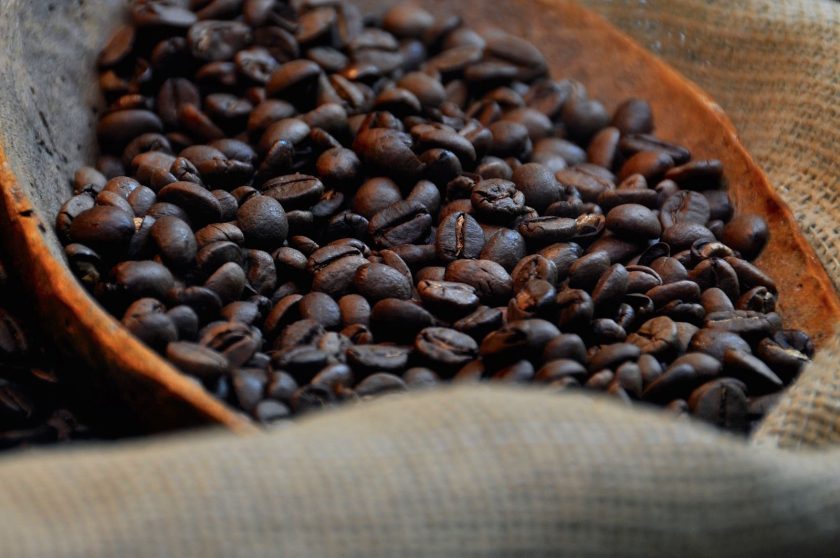
While there is an advantage to use darker roasts when brewing espresso, this is only valid for beginner baristas. Darker roasted beans are easier to extract, because the soluble solids in the beans are easier to dissolve.
From a technical perspective, a dark roast gives the barista more chances to pull a passable shot. I personally recommend beginner home baristas to use dark roasts, and “espresso blends”. As they progress and acquire experience and confidence, they could start to diversify their beans choice, using single origin, and lighter roasts.
Espresso Makers
Not all espresso machines are Espresso Machines. A confusing statement, you might think… You will often see machines labeled as “espresso machines”, or “espresso makers”, but they are not true espresso machines in the modern sense of the word. They cannot produce an authentic espresso drink.
A modern espresso machine must produce high pressures (at least 9 bar, or 135 pounds per square inch pressure). We need this kind of pressure to push water through a very finely ground, compacted bed of coffee. The coffee is compacted with a special tool called tamper, in order to create more resistance. With more resistance, we can create the needed pressure during extraction. If the machine doesn't create enough pressure, the water would just pool on the coffee puck, and not pass through.
There are many faux espresso machines that are in effect electrical “moka” style pots, relying solely on steam pressure to push water through the ground coffee. Steam pressure can produce at best 50 PSI or about 1.5 bar of pressure, with some going as high as 3 bar. These machines cannot produce the true crema that pump-driven and lever operated espresso machines can produce.
These are steam driven espresso makers, and are usually sold for under $75 on the market. You recognize a steam driven espresso machine by the amount of coffee it can extract at once. They typically include a 4 cup carafe, and they can pull a 4 cup “faux espresso drink”.
Another espresso maker candidate is the moka pot. While they make an excellent coffee, they rely solely on steam pressure and they can produce about 1 bar pressure. They are very popular in Italy, and are found in most Italian homes.
From a purely lexical perspective any machine that pushes water under pressure through a compacted bed of ground coffee is an espresso machine. We have in this category the steam driven espresso machine and the moka pot, (stove-top espresso maker).
When the term espresso was coined by Bezzera and Pavoni in the early 1900s, the machine that brewed it was steam driven. It did create a lot more pressure than your typical modern day steam driven espresso maker, but that was a commercial machine. So the lines are a little blurred here.
If you are new to the espresso machine world, you will probably find our Espresso Machine Buying Guide article helpful.
Takeaway: if you need espresso to prepare lattes, any espresso machine would do. When the espresso flavor is important, and you want a beverage similar to the one you buy in a coffee shop, a pump driven espresso machine is the way to go. Most popular espresso drinks require specialized equipment for preparation.
How to Drink Espresso
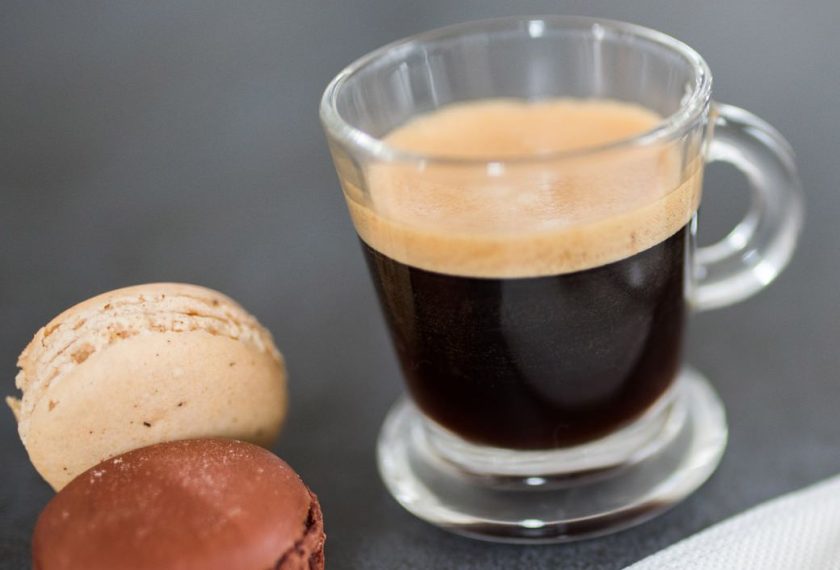
Contrary to a lot of the advice on the Internet, you need to take your time to drink your espresso. Especially if you have a double shot. If it cools down a little it's not a big deal, but just don't gulp it in one sip.
Firstly, you don't get to enjoy it if you drink it too fast. It's like good quality chocolate, or wine, take your time to savor it and discover all of the flavors.
Secondly, there is a considerable amount of caffeine in a double shot espresso, about 80 mg. Downing a doppio, is like gulping ¾ of a cup of regular coffee in a second. It's a caffeine hit that will give you some jitters.
Give the espresso a stir. Espresso is not homogenous, the thick, syrupy part of the shot tends to sink to the bottom while the brighter notes float on top. Also, when you stir it, you mix the crema into the coffee. The cup gets a more balanced taste this way. Give the espresso a good stir with a little espresso spoon.
Savor it. Take a sip and let the coffee cover your tongue. Pay attention to the aftertaste. What flavors linger in your mouth after you swallowed it? Don't be afraid to slurp, though this might be frowned upon in some circles. Slurping enhances the taste, it's a fact.
Italians often take sugar in their espresso, and there is really no stigma against adding sugar to your own shots. However, truly great espresso can be drunk sugar-free, and the sensation gives you more of a complete taste and experience of the essence of the shot you drink.nI personally like to add a little sugar in my shots sometimes.
Espresso is served in small white china cups, (50-100 ml capacity), with an elliptical shape. This is actually a specification by the Istituto Nazionale Espresso Italiano in their Certified Italian Espresso guide. The shape and the material are important for preserving the flavors inside the cup and maintaining the beverage temperature.
Finally, in many cafes worldwide, espresso is served with sparkling water. The water serves for cleansing the palate, but also to dilute the 80 mg of caffeine, and to mitigate the dehydration that comes with it. So, please drink it. It's good for you.
That is the basis for how modern day espresso, how it is prepared, served, and drunk. You could stop reading here, but if you want to find out more about what modern day espresso is all about, what machine choices exist, and how to get the best out of your own machine choice, we invite you to read our equipment review articles.
